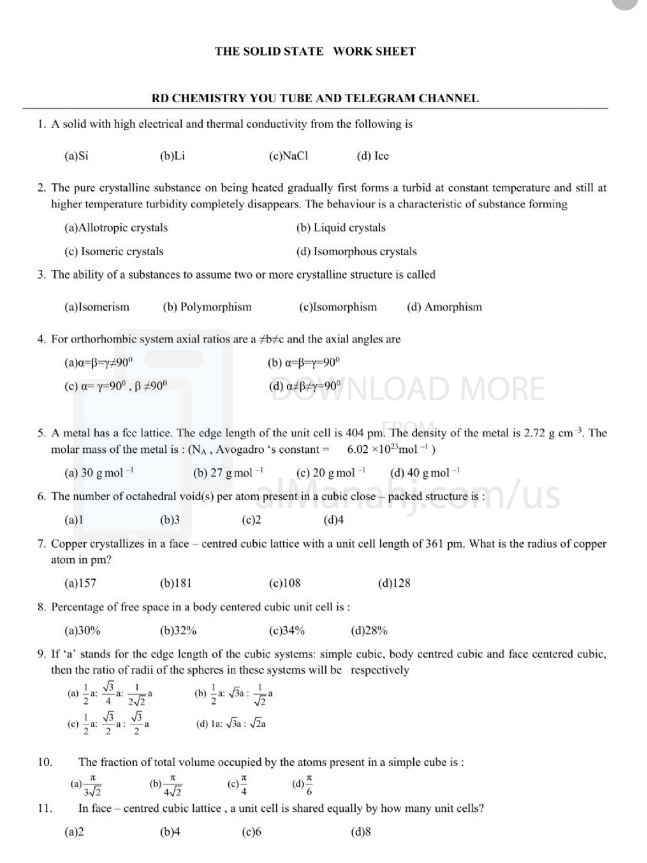| You are here: Almanahj Website ⇒ American curriculum ⇒ 9th Grade ⇒ Chemistry ⇒ Term 1 | ||
|---|---|---|
Solid state worksheet | ||
|---|---|---|
| Subject: Chemistry | ||
| 9th Grade | ||
| Term 1 | ||
| Year: 2023/2024 | ||
| Size: 338.7KB | ||
| Number of clicks: 106 | ||
| Publish date:November 06, 2023 | ||
| Added by: Eman | ||
| Last download date: 2024-08-22 02:38:47 | ||
| Updated by: Eman9966 on 2023-11-06 05:44:26 | By: theodor ruben | |
| File info: In chemistry, the solid state refers to the physical state of matter in which substances exist as solid materials. Solids are characterized by their definite shape and volume, with particles tightly packed together in a regular arrangement. In the solid state, the atoms, ions, or molecules that make up a substance are held together by strong intermolecular forces, such as ionic bonds, covalent bonds, metallic bonds, or van der Waals forces. These forces create a three-dimensional lattice structure, which gives solids their rigidity and stability. The properties of solids are distinct from those of liquids and gases. Some key characteristics of the solid state include:1. Definite Shape and Volume: Solids maintain a fixed shape and volume, as the intermolecular forces keep the particles closely packed in a specific arrangement. 2. Strong Intermolecular Forces: The particles in solids are held together by strong intermolecular forces, which require significant energy to overcome. This gives solids their high melting and boiling points compared to liquids and gases. 3. Low Compressibility: Due to the close packing of particles, solids have very low compressibility. The intermolecular forces prevent significant changes in volume under pressure. 4. Ordered Structure: Solids exhibit a regular and ordered arrangement of particles in a crystal lattice or an amorphous structure. This arrangement contributes to the characteristic properties of different types of solids. 5. Mechanical Strength: Solids are generally rigid and have high mechanical strength due to the strong intermolecular forces that hold their particles together. 6. Limited Molecular Motion: In the solid state, particles have limited movement, vibrating around fixed positions within the lattice structure. This restricted motion contributes to the solid's stability and lack of fluidity. The solid state is incredibly diverse, encompassing a wide range of materials with varying properties. Solids can be classified into different categories based on their atomic or molecular structure, including crystalline solids, amorphous solids, and composite solids. Crystalline solids have a well-defined, repeating arrangement of particles in a crystal lattice, resulting in specific geometric shapes and characteristic properties. Examples of crystalline solids include salt (sodium chloride) and diamond. Amorphous solids, on the other hand, lack long-range order in their atomic or molecular arrangement. They have a more random structure and include substances like glass and some plastics. Composite solids are made up of a combination of different types of particles or materials. They can have unique properties that arise from the interactions between the different components. The study of the solid state is essential in materials science, solid-state chemistry, and various technological applications. Understanding the structure and properties of solids allows scientists to develop new materials with tailored properties, explore their behavior under different conditions, and advance technologies such as electronics, energy storage, and drug delivery systems. In summary, the solid state in chemistry refers to the physical state of matter characterized by a fixed shape, strong intermolecular forces, and an ordered arrangement of particles. Solids play a crucial role in various fields of science and technology, and their properties are influenced by factors such as the type of bonding, crystal structure, and composition. | ||
| Downloading link Solid state worksheet |
|---|
|
1699249406.pdf
The file is being prepared for download
|
| File images |
|---|
 |